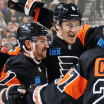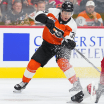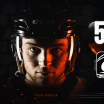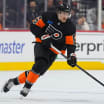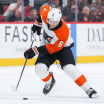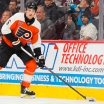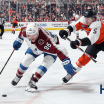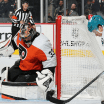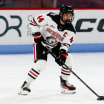Alain Vigneault's Philadelphia Flyers (5-2-2) will be in action for the 10th time this season when they face Peter Laviolette's Washington Capitals (5-1-4) at Capital One Arena in DC on Saturday. Game time is 7:00 p.m. ET (NBCSP, 93.3 WMMR).
5 Things: Flyers @ Capitals
Alain Vigneault's Philadelphia Flyers (5-2-2) will be in action for the 10th time this season when they face Peter Laviolette's Washington Capitals (5-1-4) at Capital One Arena in DC on Saturday
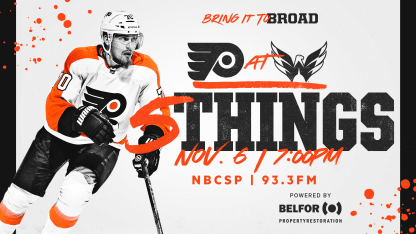
This is the first of four meetings between the Metro Division rivals this season. The teams will rematch at the Wells Fargo Center on Dec. 21 and Feb. 26 before the regular season series concludes back in Washington on April 12. Last season, the Flyers went 2-5-1 in eight games against the Capitals. The prior year, the Flyers were 3-0-1 versus the Capitals, plus a round-robin victory at the start of the 2020 postseason.
The Flyers enter this game coming off a 3-2 overtime road loss to a severely undermanned Pittsburgh Penguins team, Carter Hart was stellar in net, and was primarily responsible for the Flyers getting a point from the game. Travis Konecny (power play, 4th goal of the season) and Scott Laughton (3rd) tallied for the Flyers.
The Capitals are coming off a Florida road trip that saw the club gain only one of four possible points from back-to-back hard fought games in Tampa against the Lightning (3-2 loss in regulation) and in Sunrise against the Panthers (5-4 overtime loss). The latter game saw the Caps battle back from a 4-1 deficit to send the game to OT. Washington forward Connor McMichael's first career NHL goal knotted the score at 4-4.
The game ended up a fluky play. Washington's Tom Wilson's defensive stick broke up an attempted cross-ice pass by Florida's Eetu Luostarinen but accidentally deflected the puck into the net.
In Sunrise, Hockey Hall of Fame shoo-in Alex Ovechkin fired home career goal no. 740. He is one goal away from tying Brett Hull for fourth on the NHL's all-time goal-scoring list.
Here are five things to watch in this game:
1. The Brassard line.
The Flyers trio of Derrick Brassard centering Joel Farabee and Cam Atkinson got off to a strong start together during the season-opening four-game homestand. However, they've struggled as a line in most of the games since, apart from making a nice play here and there.
Stats can be deceptive but, in this case, they match the eye-test: the Farabee-Brassard-Atkinson line has spent way too much time hemmed in the Flyers' defensive zone over the last five games.
Over that five-game span, Brassard (33.66 percent Corsi, 35.44 percent Fenwick, 34.42 percent Expected Goals), Farabee (34.14 percent Corsi, 35 percent Fenwick, 30.87 percent Expected Goals) and Atkinson (36.36 percent Corsi, 37.21 Fenwick, 33.72 percent Expected Goals) rank at the bottom among all Flyers skaters in terms of-ice total shot attempt differentials at 5-on-5 (CorsI), total unblocked shot attempt 5-on-5 differentials (Fenwick) and scoring chance quality differentials at five-on-five,
It should be added, though, that this was the line that was on the ice against Arizona for the controversial would-be Atkinson goal set up by Brassard. The play was ruled a goal on the ice by the near-side referee (who was in poor position) but then reversed retroactively after consulting the other three officials. The eventual ruling was that Arizona's goaltender had covered the puck long enough for a stoppage. The goal was taken off the board.
Atkinson, who racked up six goals in the first five games of the season including two goals in Edmonton, has not recorded a point in the last four games. Nevertheless, he has generally continued to play well. Atkinson was moved up from the second power play unit to PP1 two games ago and remains a mainstay on what looks to be an improved Flyers penalty kill.
Things have been rougher for his two linemates of late.
Farabee was not noticeable offensively in most of the team's recent games although he did seem more active in the Pittsburgh game and recorded four shots on goal. When Farabee is on his game, he has the puck on his stick or is applying off-puck pressure on most of his shifts.
That has not been the case of late, and Farabee's streak of six straight pointless games (with zero or one shot on goal in four of the games) accurately reflects the process and not just the result. Likewise, Farabee had the puck frequently on the opening homestand, and it played out into three goals and three assists over the season's first three games.
Brassard, for a while, had seemed to turn back the clock. The 34-year-old swingman helped the Flyers cope without the injured Kevin Hayes as the season opened. Even since then, he's passed the puck well when he has it on his stick. The problem has been the long stretches where he and his line have not had possession. Overall, Brassard has five assists and six points in the first nine games. However, as with Farabee, the production is a reflection of the earliest games of the season and not the last couple weeks.
The struggles of the Brassard line has added to the burden of the Flyers No. 1 line at 5-on-5 (Sean Couturier centering Claude Giroux and Travis Konecny) and the top PP unit to provide most of the scoring. The Scott Laughton line is creating a lot of Philadelphia puck possession and a very impressive number of scoring chances relative to their 5-on-5 ice time, but the goals were scarce until the last two games.
Assuming there are no line combination changes by the Flyers in Washington -- unknown as of this writing -- a bounceback game from the Brassard line is something the Flyers may need to significantly improve their chances of finding a way to win in Washington. Lately, it's been too top heavy.
2. Feeling the Ellis Absence
If the Flyers can find a way to win in Washington, they'll be off to a 6-2-2 start through the first 10 games of the season. Considering all the new faces on the roster and the absences of top-pairing defenseman Ryan Ellis (for all but the first three games) and second-line center Hayes, that'd be a solid foundation off which to build.
It is possible that the Flyers could have one or both of Ellis and Hayes in the lineup next week when they host the Toronto Maple Leafs. However, neither player will be available for this game in Washington and there's no precise timeline set yet for either's return.
Justin Braun has done an admirable job playing up top on the defensive rotation with Ivan Provorov (who is off to an excellent two-way start to the season). Nick Seeler has played with moxy and competitiveness filling in within the starting six. However, the Flyers have begun to feel the impact of being without Ellis.
For one thing, Ellis' presence not only gives the Flyers up to about 25 high-quality minutes across all manpower situations, he also brings a calming presence when things get chaotic.
The Flyers miss Ellis' ability to consistently get shots through to the net, make good use of a defensive stick, trigger the breakout and make intelligent decisions on when to pinch and when to hang back. Every player makes some mistakes or has a bad shift or two, but the good plays far outnumber the bad with Ellis.
The breakout is especially important against a team like Washington. Of late, there have been games where two-thirds of the Flyers blueline has struggled in moving the puck. Along with gap management, the Flyers ability (or lack thereof) to get clean defensive zone exits and navigate the neutral zone, will loom large in preventing the Capitals from dictating the game to Philadelphia.
When Ellis is in the lineup, the Flyers can slot their blueline minutes and matchups more ideally. When Ellis is out, the rest of the starting six -- especially Braun in Ellis' five-on-five spot, and the second pairing of Travis Sanheim with Rasmus Ristolainen -- have to shoulder a bigger share of the load and handle tougher matchups.
Ristolainen has had some individual ups and downs in the early going of the season, although he's unquestionably a warrior and has very recently started to show more of his offensive game. Sanheim, too, has been a bit uneven in his play, with some good games and some so-so ones. The Flyers could use a simultaneous series of strong games from both halves of the pairing (both before and after Ellis comes back).
As with Brassard, defenseman Keith Yandle opened the regular season looking like he'd turned back the hands of time to his years as a three-time NHL All-Star offensive defenseman. It hasn't gone quite as well of late but Yandle's professionalism is obvious on a day-in and day-out basis. Seeler battles hard and brings a physical presence and some shot-blocking prowess but has struggled against aggressive forechecking teams.
3. By the Numbers
The second-period bugaboo reared its head again on the Flyers in Pittsburgh. The team entered and exited the period down by a goal but they were dominated territorially for much of the period. That's happened too frequently through the first nine games of the season for the Flyers. Over the last two games, first periods were a bit too loosey goosey as well.
However, overall, Philly has been a good first period club and a very good third period team. Second periods have been a struggle going back to opening night against Vancouver.
Last season and in two preseason meetings in 2021, the Capitals power play did major damage to the Flyers when the teams played head-to-head. Earlier this season, the Flyers played Boston (another team that shredded Philly on the power play a season ago) and only took one penalty.
The Flyers need to show similar discipline against Washington. Before late-season injuries and COVID cases depleted the Caps lineup in their final two games against the Flyers, Washington was 7-for-14 on the power play against the Flyers across the first six meetings. They also talled three power play goals against the Flyers in two preseason games this September/October.
Although the Flyers managed to play a penalty-free game against Arizona on Tuesday and then go 3-for-3 on the PK in Pittsburgh, Philly remains one of the NHL's most penalized teams overall. The Flyers' penalty kill has looked significantly improved overall in the early going of the new season but it would be wise not to press their luck against the Caps.
4. Behind Enemy Lines: Washington Capitals
Father Time has not yet slowed Ovechkin. Even without the supreme playmaking talents of Nicklas Bäckström (LTIR, hip) in the Washington lineup, Ovechkin has been just as deadly as ever. He's opened the season with a league-leading 10 goals in 10 games. With 18 points overall, it's the best 10-game offensive start to his illustrious career. This season marks the third time in his career that Ovechkin has been the first player in the league to score his 10th goal.
The Capitals are dealing with their share of injuries, even apart from the absence of Bäckström. Anthony Mantha (left arm/shoulder) was injured in the Florida game and placed on injured reserve. T.J. Oshie (foot) also remains on injured reserve.
Even without these players, the Capitals remain a handful for opponents. Evgeny Kuznetsov has opened this season with 13 points (5g, 8a) over the first 10 games. Veteran offensive defenseman John Carlson has seven points (2g, 5a) and continues to make opponents pay for over-playing to take away Ovechkin's lethal one-timer.
Opponents league-wide know they have to keep their heads on a swivel whenever Tom Wilson -- who remains arguably the league's most hated opponent but also one that other teams admit they'd like to have on their side -- is on the ice. Through 10 games, he has eight points (1g, 7a), 27 credited hits and 16 penalty minutes.
Dealing with Washington's heaviness and physicality -- starting with Wilson but also in several other places around their lineup -- is a significant part of the challenge for any opponent. The agitating Garnet Hathaway does not have a point yet but has racked up 24 hits already in an average 12:11 of ice time. Defenseman Martin Fehervary has 26 hits (plus 18 blocked shots).
Neither Ilya Samsonov nor Vitek Vanecek have been unsolvable in goal thus far for the Capitals. Despite their key absences in the lineup, Washington is still a team that doesn't mind trading scoring chances over significant stretches of games, and they'll give up their share of opposing scoring chances. The blueline is not as deep as it was during their Stanley Cup winning season a few years ago; in fact, not as deep as it was even last season.
The bottom line is this: Samsonov is 3-0-1 so far, while Vanecek is 2-1-3.
5. Players to Watch: JVR vs. TVR
It's always fun to watch hockey brothers compete against one another. Veteran Flyers winger James van Riemsdyk has a close off-ice relationship with his younger brother, Capitals defenseman Trevor van Riemsdyk. Of course, on the ice, that goes by the wayside for a little while when their teams play against one another.
JVR has been rather snakebitten in the early going of the 2021-22 season, along with linemate Oskar Lindblom (0g, 1a). Their line with Scott Laughton (who has scored goals in back-to-back games) has often been either the most or second-most effective Flyers line this season. They've consistently generated forechecking pressure, forced opposition turnovers, created scoring chances and backchecked diligently. JVR has also passed the puck effectively, and collected four assists.
Nevertheless, neither of the wingers on the Laughton line has scored a 5-on-5 goal yet. JVR scored a power play tap-in goal while playing on the top unit (he's since been moved to PP2). Lindblom is still looking for his first goal of any kind this season.
As noted above, the Flyers may tweak line combinations at some point. There will, naturally, be adjustments when Kevin Hayes (LTIR, abdominal muscle surgery) returns. Could it happen beforehand?
On Washington's roster, Trevor van Riemsdyk has been a solid piece of the team's blueline puzzle. He's dressed in all 10 games, blocked 14 opposition shot attempts, chipped in four assists and averaged 17:16 of ice time.




